Friday May 29th, Hans Alf Gallery invites everyone to celebrate the opening of Mie Olise Kjærgaard’s new show “Hysteria” in our main gallery.
In “Hysteria”, the audience is welcomed into a postapocalyptic utopia, where woman have finally gained the power and respect, they deserve. In a series of imposing and colorful paintings, Kjærgaard portrays the archetype of the strong and silent woman, who has been overlooked, oppressed and disenfranchised throughout history, but who is in fact – according to the artist – the backbone of every society.
Kjærgaard herself sees “Hysteria” as a natural continuation of “News from Nowhere” from 2018, where through a comprehensive series of cityscapes and tableaus she depicted life in a fictional, matriarchal metropolis called “Moirania”. In “Hysteria”, the highly versatile painter zeroes in on the women, who make up everyday life in Moirania. They play tennis, they bike, they work, they form picket lines and move about by horseback – all with the same, stern and impenetrable gaze towards the viewer, who is left almost embarrassed.
“Hysteria” shows a brand-new side to Mie Olise Kjærgaard, and the show represents an indisputable quantum leap in her artistic practice. After an energetic (and refreshing) foray into what is generally referred to as “bad painting”, Kjærgaard’s new body of work is a masterly demonstration of her technique and coloristic ability. A delight to the eye and a call for contemplation.
Art historian and curator, Christina Wilson, writes the following about the show:
"In a world, where women must still fight for equality, be it in arts or boardrooms, Kjærgaard borrows the title of her show from the Greek “hystereraos”, which is an obsolete medical term meaning uterus. Throughout history, women have been said to be hysterical, whenever they exhibited dramatic, attention seeking or theatrical behaviour. Critical, female psychoanalysts have pointed out that hysterical symptoms ought to be perceived as valves for the oppression of the free expression of women."
"Mie Olise Kjærgaard operates on multiple levels in her works. Her dreams of a new social order run in parallel with the notion of timelessness. With her staunch, energetic women, she wants to rebel against the infamous male gaze, of which film critic Laura Mulvey wrote in her 1975 essay “Visual Pleasure and Narrative Cinema”. That specific male gaze, which maintains and perpetuates women as sexualized beings, confined in the picture frame as scintillating odalisques or sacred madonnas."
"In HYSTERIA, Kjærgaard has chosen to show us fierce, emancipated women, because even though we claim that equality is a Danish core value, power is still unevenly distributed among the two genders."










